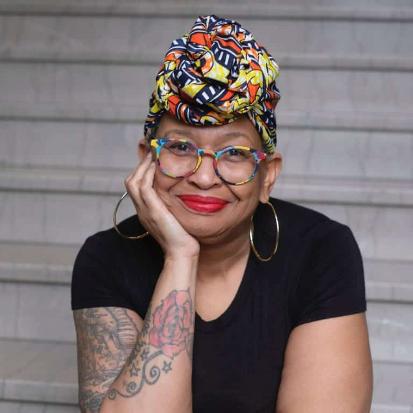Still: The Journal: Could you talk a little about how you got started as a writer? What paths did you take toward writing?
Claudia Love Mair: My mother and my grandmother moved to Detroit from Middlesboro, Kentucky during the “Great Migration.” I was raised in a little town just north of Detroit called Inkster, which is kind of a fun placename for a writer (or a calligrapher or tattooist). I grew up in a Black neighborhood; I went to all-Black schools until I went to college. There were parts of my childhood that were lovely, but there were also parts that were very chaotic. We lived in a housing project when I was very little, and then we moved into a house directly across the street from the housing project. I felt like the soundtrack for my high school years was constant sirens and police. And there was a lot of chaos at home, a lot of violence in my home, addiction. And I turned to the church for solace. I became a Christian when I was 15, and by the time I was 16, I was actually a minister—a little preacher, a teenage missionary. And throughout that time, I wrote; I told stories; I wrote awful poetry; I wrote sermons, but the novelist in me was definitely being born in that phase of my life.
I was not raised by my parents. I was raised by my great aunt and uncle because I was a very sickly child, and my mom had nine kids. I was number seven, and she was only 27 years old when she had me. But I had such severe asthma. And my father had a really bad alcohol and drug problem, and my mother was just in over her head. So at 15 months old, my grandmother and my great aunt talked my mom into letting me stay with my great aunt because they had a car, and my mother didn’t. And if I needed to get to the hospital, which I often did, they were able to take me. My mom still feels guilty about that to this day. But I tell her: “All you did was save my life.”
Still: Did you have encouragement from any of your school teachers to pursue writing?
CLM: I think this might be the moment I became a writer: I was walking down the hallway at school one day and saw a piece of paper on the ground. And I have no idea why I stopped and picked it up. It had dialogue, like from a play. I looked at it, and I said, “I can do this!”—with no interest ever before that moment wanting to write. I always drew, so my mom said I would be an artist one day, but no one saw “writer” for me. So I wrote a little play, and I asked my fifth-grade teacher, Mr. Wilson, if some of my classmates and I could perform it, and that began my life as both a writer and an actress because I acted in the plays. It was such an escape from the chaos of my life.
Still: It's easy to see how your early experiences might lead you to writing and even to the church. Do you still have those spiritual or religious leanings? You've referred to yourself as a “Catholic but I’m really bad at it.” Does spirituality tie into your creative self as a writer?
CLM: I would say that I’m better at being a “witchy” Catholic today. I wasn’t raised Catholic but became one around age 42. I was raised in the Black Pentecostal tradition, in the Church of God in Christ, which is very conservative. But before I became Catholic, I was a practicing Eastern Orthodox because I wanted what I thought was the top, the oldest, form of Christianity. Literally Orthodox, which means “right teaching.” But eventually, I was drawn to a wider, more expansive spirituality, and this is really how my career started.
I was 40 years old, my husband needed surgery, and we were dirt poor. He wasn’t working; he had a raging drug habit; and I had just gotten diagnosed with fibromyalgia. I was in pain all the time. We were so impoverished that we went to his surgery on the city bus. In the waiting room I saw a copy of Today’s Christian Woman, and it had a Black woman on the cover, something I had never seen before on Today’s Christian Woman. I was so shocked. It felt like a sign, almost. There was an article inside about Brennan Manning’s book The Ragamuffin Gospel—kind of a gospel for outcasts and misfits and spiritually broken people. I read every bit of the magazine. I stole it. I took it home. I read it again, and I held it to my heart and said a prayer, “Jesus, if you will let me write for you, I promise I will tell people like me that you love them.”
Still: So did you get your start in the Christian publishing market?
CLM: I felt like there was no place for me in Christian publishing. I didn’t see anyone who looked remotely like me. I didn’t fit the profile. In 2004 I started a blog called “Ragamuffin Diva,” because I really resonated with Brennan Manning’s book. I didn’t have a thing to lose. So I decided to tell the truth: what it was like to live with mental illness, chronic pain, a drug-addicted husband, poverty. So I wrote about my own messy spiritual journey.

